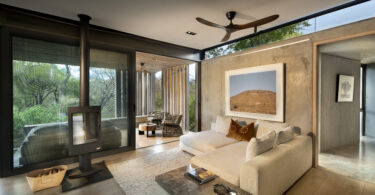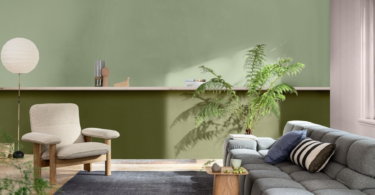A long, ‘skinny’ room doesn’t have to look like a tunnel with no end. Clever furniture placement and other décor tricks can make the space feel rather cosy. Here’s how…
Give it purpose – A good starting point, before you decorate any long and narrow room, is deciding how you’d like to use it. Will it be a TV lounge, study, dining room or craft space for instance? This will help you with furniture placement and how best to break the room up into sections.
Have more than one seating area – Try dividing a narrow living room into two or more seating areas. This will allow you to use ‘normal-size’ furniture and set up each area for a different purpose or level of cosiness (formal seating in one spot, comfy ottomans in another).
Be consistent – Stick to a particular style or theme, as well as a set colour palette, so the space feels harmonious from end to end. Using different shades of the same colour will help create dimension – match up rugs and upholstery to help unify the space and draw the eye to certain points around the room.
Don’t push everything against the walls – This will only serve to emphasise the narrowness of the space and make it look lopsided. Try placing pieces in the middle of the room too. Your aim is to try and make the room look and feel visually ‘balanced’. Even sit some furniture at an angle to break up the long, straight lines that are common in narrow rooms.
Think bigger pieces – Whether it’s an extra-length coffee table or two matching ones placed side by side, a daybed (instead of a couch), an especially tall wingback chair or even a grand piano, think furniture that will match the room’s scale. Make sure that accessories follow the same example (for instance, that your rug extends the full length of the couch).
Light it up – Lighting all the dark corners will make the space feel cosier and less like an endless, shadowy tunnel with no boundaries or defined edges. In a narrow room with a high ceiling, hanging lights will help lower the ceiling’s perceived height, while a skylight will help draw the eye up in the case of a low ceiling, increasing the feeling of height and making the space feel more airy.
Use the wall space – Mounting shelves and bookcases up high on the wall can help cut down on using the floor space. Also consider built-in and hidden storage for less clutter and cleaner lines.
Trick the eye – Architectural elements like archways, columns and recessed ceilings can be helpful in breaking up a large space, as can screens and bookcases. Also use warm, dark colours, busy patterns and/or over-sized art on the wall at the far end of the room to make it appear closer than it is.
Direct traffic – One of the biggest dilemmas with arranging furniture in a long and narrow room is where to have people walk through. You have to try and make the path as obvious as possible. Avoid sending foot traffic between a chair (or couch) and the coffee table, for example. If there’s no other way, then just say ‘no’ to too many pieces of furniture and scratch having a coffee table altogether. Don’t allow furniture to stick out into the walkway either. Also, place floor rugs in such a way that you either walk right across them or stay completely off them.
Think less ‘angular’ pieces – Using round furniture can help counteract the very linear feeling you get in narrow spaces (plus, you won’t bang knees and shins on sharp corners when there’s a tight squeeze to get in and out). Covering a corner of the room with a screen, for instance, will also visually change the shape of the room a bit by rounding out the corner.
Have you decorated a long and narrow room before? Share your tips with us…











Leave a Comment